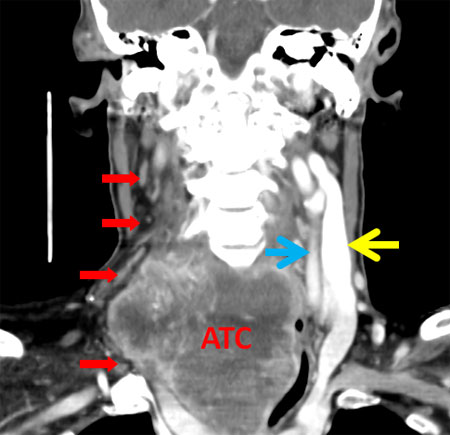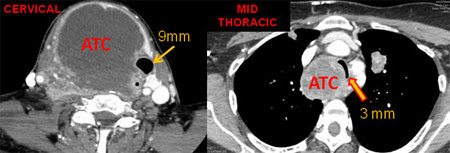73-year-old woman with acute dyspnea and enlarging neck mass
Click Here to Manage Email Alerts
A 73-year-old Caucasian woman was admitted with acute dyspnea with a rapidly enlarging neck mass. She noticed the mass 6 months earlier, but sought care after a marked increase in neck size with solid food dysphagia and hoarseness. She had no prior history of malignancy or thyroid disease. She worked for a cardiologist during the 1950s who performed fluoroscopy without radiation shielding, but otherwise had no history of head and neck radiation. Her family history was negative for thyroid disease or thyroid cancer.
A CT scan of the neck and thorax revealed an 8 cm × 7 cm × 16 cm cystic, non-calcified neck mass in the right thyroid displacing the trachea and esophagus and extending into the mediastinum to below the carina (Figure 1). The mass obliterated the right jugular vein and carotid artery (Figure 2). There were innumerable pulmonary nodules (Figure 1).
 Stephanie L. Lee |
 Ava Port |
Physical examination revealed a thin woman with a 7 cm × 6 cm non-tender, very firm, immobile mass extending from the left neck across to the right posterior neck. No lymphadenopathy was appreciated in neck. The trachea was deviated about 3 cm leftward without respiratory distress. Stridor occurred when she used long sentences. Pemberton’s maneuver caused immediate onset of stridor and facial plethora. Thyroid function tests were normal.
|
Figures reprinted with permission from:
Stephanie L. Lee, MD, PhD |
|
|
Core biopsy showed anaplastic thyroid carcinoma (ATC) with highly abnormal nuclei in a spindle pattern and mitoses. Otolaryngology performed an indirect laryngoscopy showing paralysis of the right true vocal cord and a patent upper airway with full glottic closure. They felt her airway was patent and recommended no additional intervention. Further review of imaging by endocrinology recognized that although her upper airway was slightly narrowed, a critical stenosis was present much lower in the mediastinum just above the tracheal bifurcation (Figures 1 and 3). Endocrine recommended urgent consult with a cardiothoracic surgery for lower airway management to avoid respiratory failure.
Overnight, she developed hypoxemic respiratory failure and stridor. After high-dose IV dexamethasone, she stabilized and did not require intubation. Cardiothoracic surgery subsequently placed two overlapping uncovered, expandable metal tracheal stents via rigid bronchoscope under general anesthesia. She was extubated 36 hours after the procedure and had no further respiratory problems. She received palliative radiation (30 Gy in 10 fractions) and two cycles of palliative chemotherapy of carboplatin and paclitaxel resulting in shrinkage of mass, stabilization of her clinical status and enrollment in a clinical trial.
ATC is a highly aggressive thyroid cancer that represents less than 2% of thyroid malignancies, yet accounts for about 40% of thyroid cancer deaths. ATC incidence peaks in the 6th to 7th decade and affects women 1.5 times more often than men. ATC has limited response to multimodal therapy with a median survival of 4 to 12 months and more than 80% mortality at 1 year. At diagnosis, more than 50% of patients have metastatic disease and more than 70% will have local invasion. Patients with ATC present with rapid growth of a thyroid mass and related compressive symptoms, such as dyspnea, stridor, dysphagia, pain or hoarseness with unilateral or bilateral vocal cord paralysis.
Clinicians must consider the entire airway when evaluating any patient presenting with advanced thyroid cancer, lest a critical stenosis be overlooked. The adult trachea is 10 cm to 14 cm long, supported anteriorly by a series of cartilaginous rings, and narrows from a diameter of about 25 mm to 16 mm before bifurcating into bronchi. Patients typically become symptomatic after 50% stenosis occurs, and dyspnea at rest after 75% stenosis. In our case of progressive dyspnea with a rapidly growing tumor, the upper airway was 50% to 60% compressed, whereas her thoracic airway, which cannot be visualized by indirect laryngoscopy, was 80% to 85% stenotic (Figure 3), resulting in respiratory failure.
|
|
Management of ATC with respiratory failure is largely directed at palliative measures without radical surgery. Endobronchial stenting will maintain airway patency and improve quality of life in patients with airway obstruction while they undergo palliative treatments. A variety of stents are available, including rigid silicone, expandable metallic and hybrid stents. Silicone stents are less expensive and easiest to insert, but more likely to migrate or occlude from sputum retention. Self-expanding metal alloy stents coated in a polyurethane mesh reduces in-growth of endobronchial tumor and granulation tissue, but if left uncoated allows mucociliary clearance and minimizes occlusion by sputum. Metallic stents are less likely to migrate, but considerably more difficult to remove than silicone stents due to epithelial in-growth. Regardless, airway dilation by stenting should be considered when there is significant tracheal obstruction by tumor to improve dyspnea and to allow time for palliative treatments.
Ava Port, MD, is a fellow in endocrinology at the Boston Medical Center. Stephanie L. Lee, MD, PhD, is associate professor of medicine; associate chief, section of endocrinology, diabetes and nutrition; and associate professor of medicine at the Boston Medical Center.
For more information:
- Green LD. J Surg Oncol. 2006;94:725-736.
- Kim WK. Acta Radiol. 2010;51:768-774.
- Noppen M. Chest. 2004;125:723-730.
- Tsutsui H. Respirology. 2008;13:632-638.
Disclosures: Drs. Lee and Port report no relevant financial disclosures.



